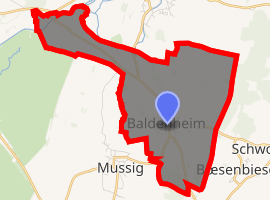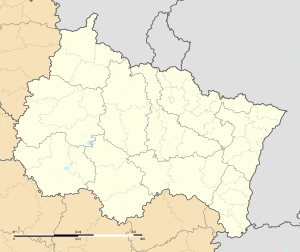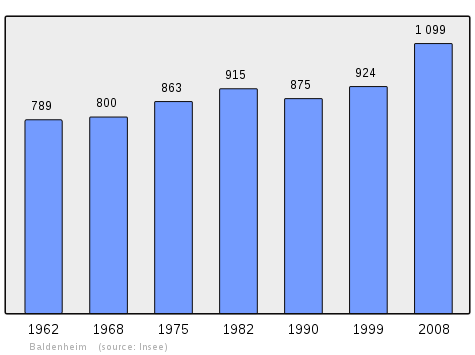Baldenheim
Baldenheim is a commune in the Bas-Rhin department in the Alsace region of north-eastern France.
Baldenheim Bàldene | |
|---|---|
A House in Baldenheim | |
 Coat of arms | |
Location of Baldenheim 
| |
 Baldenheim  Baldenheim | |
| Coordinates: 48°14′19″N 7°32′21″E | |
| Country | France |
| Region | Grand Est |
| Department | Bas-Rhin |
| Arrondissement | Sélestat-Erstein |
| Canton | Sélestat |
| Intercommunality | Sélestat |
| Government | |
| • Mayor (2001–2020) | Willy Schwander |
| Area 1 | 9.44 km2 (3.64 sq mi) |
| Population (2017-01-01)[1] | 1,169 |
| • Density | 120/km2 (320/sq mi) |
| Time zone | UTC+01:00 (CET) |
| • Summer (DST) | UTC+02:00 (CEST) |
| INSEE/Postal code | 67019 /67600 |
| Elevation | 165–172 m (541–564 ft) |
| 1 French Land Register data, which excludes lakes, ponds, glaciers > 1 km2 (0.386 sq mi or 247 acres) and river estuaries. | |
The inhabitants of the commune are known as Baldenheimois or Baldenheimoises.[2]
The commune has been awarded two flowers by the National Council of Towns and Villages in Bloom in the Competition of cities and villages in Bloom.[3]
Geography
Baldenheim is located in the Canton of Marckolsheim and the Arrondissement of Sélestat-Erstein in the centre of the Alsace region on the alluvial plain of the Rhine, 45 km south of Strasbourg, 26 km north by north-east of Colmar and 8 km east of Sélestat. Access to the commune is by the D605 from Hessenheim in the south which passes through the village and continues north to Muttersholtz. The D209 comes from Schwobsheim in the east and passes through the village continuing west to join the D21 near the commune border. The D208 goes south-west from the village to Mussig.[4]
Natural environment
The commune is at the centre of a flat alluvial plain and is part of the Ried Natural Region. The water table is only 1.50 metres below the surface on average. Water pierces the clay layer and gives rise to waterways. The Ill river flows relatively calmly across the plain. Like all the rivers in Vosges it is subject to an oceanic regime which is characterized by high winter waters and low summer waters, contrary to the Rhine. The last catastrophic flood occurred in May 1983. The climate is of semi-continental type with about 600 mm of rain per year. Temperature differences are particularly marked: summers can be very hot and the winters harsh.
Landscape
The commune outside the urban area has five distinct types of landscape:
- Suburban Village: orchards and gardens,
- Rural Open Spaces: fields and woods,
- Wetland: the Black Ried,
- Banks of the Ill: the Grey Ried,
- Forested areas.
About 80% of the utilized agricultural area is cultivated.
The Ill, the Blind and numerous streams flow north though the commune all eventually merging with the Ill which joins the Rhine at Plobsheim.
Neighbouring communes and villages
Toponymy
Bandenheim, 1182
History
There is a Merovingian and Carolingian Cemetery with a hundred graves which attest to the ancient occupation of the commune. Most of the tombs are shallow (between 0.50 and 0.60 metres below the topsoil) and contained no ornaments with disturbed skeletons indicating plundering long ago. Another group of burials are deeper (between 1.20 and 1.50 metres) and contained relatively rich ornaments (brooches in bronze and silver partitioned with garnet, glass beads, glass paste necklaces, amber necklaces, and other objects from the second half of the 6th century and the second third of the 7th century. The ornaments collected from Baldenheim are from a time period between 550 and 650.
Baldenheim appeared in a document from the second half of the 7th century in the form of Baldenheim Villa. The name of this village, according to legend, is that the Devil one day lost his hat. He refused to retrieve it saying B'haltene (keep it). The village did not have a name at that time and adopted this onomatopoeia. But the name Baldenheim does appear in the 9th century.
The Protestant Reformation was introduced in 1576. A castle was built in 1740 and destroyed in 1821. The Simultaneau in 1843 provoked a violent conflict between the two religious communities (Protestant and Catholic). In the 19th century there was significant growth in weaving and there were 150 weavers in the commune. In the last third of the 19th century, the cooperative movement developed in the commune. A savings bank was founded in 1890 and a dairy cooperative operated until 1981.
In 1324 the village belonged to the Duchy of Württemberg. It had then given in fief to the Rathsamhausen zum Stein family. Upon the extinction of this noble family, Louis XIV gave it to the engineer of Chamlay, leaving it for him to pay tribute to the Duke of Württemberg who, at the death of the commander of Chamlay passed the fief to the family of Sandersleben-Coligny. Before the French Revolution it was owned by the Waldner Freundstein family whose castle was demolished in 1820. From the 19th century home weaving occupied a very important place in the local economy.
Baldenheim is known for its festival of "Pfingstpflitteri" which was held for the tenth time in 1999.
The Merovingian helmet
In July 1902 Oscar Pfiffer discovered some objects in his field at Lange Gasse. A more thorough search uncovered a ceremonial helmet and other Merovingian objects. A study published in 1907 by R. Henning made Baldenheim the eponymous site for this type of helmet with thirty examples identified at this time.
The Baldenheim Helmet is now on display at the Museum of Archaeology in Strasbourg.
Heraldry
 Arms of Baldenheim |
Blazon: Gules, a coutre knife Argent in pale point to base, blade to dexter. |
Administration
| From | To | Name | Party | Position |
|---|---|---|---|---|
| 2001 | 2020 | Willy Schwander |
(Not all data is known)
Demography
In 2010 the commune had 1,150 inhabitants. The evolution of the number of inhabitants is known from the population censuses conducted in the commune since 1793. From the 21st century, a census of communes with fewer than 10,000 inhabitants is held every five years, unlike larger communes that have a sample survey every year.[Note 1]
| 1793 | 1800 | 1806 | 1821 | 1831 | 1836 | 1841 | 1846 | 1851 |
|---|---|---|---|---|---|---|---|---|
| 826 | 758 | 872 | 1,019 | 1,004 | 1,040 | 1,071 | 1,079 | 1,040 |
| 1856 | 1861 | 1866 | 1872 | 1876 | 1881 | 1886 | 1891 | 1896 |
|---|---|---|---|---|---|---|---|---|
| 1,032 | 1,045 | 1,083 | 1,074 | 1,042 | 1,062 | 1,049 | 1,075 | 1,079 |
| 1901 | 1906 | 1911 | 1921 | 1926 | 1931 | 1936 | 1946 | 1954 |
|---|---|---|---|---|---|---|---|---|
| 1,078 | 1,105 | 1,134 | 989 | 943 | 910 | 846 | 841 | 863 |
| 1962 | 1968 | 1975 | 1982 | 1990 | 1999 | 2006 | 2010 | - |
|---|---|---|---|---|---|---|---|---|
| 789 | 800 | 863 | 915 | 875 | 924 | - | 1,150 | - |

Economy
The ratio of active population to total population of the commune has grown above the cantonal average. There is also evidence that unemployment has decreased.
Fruit and vegetables, flowers and plants are cultivated in the commune and there are a dozen pig farmers.
The number of farms has decreased but orchards are still important and Baldenheim is known for its "white apples of Baldenheim".
The village enjoys a relatively high level of economic activity and expansion. There are 440 jobs available in the commune to over 1000 inhabitants.
Culture and heritage
Civil heritage
The commune has many buildings and structures that are registered as historical monuments:
- Farmhouses (16th-19th century)

- Other sites of interest
- The Town Hall is on the former location of the communal school which existed from 1600 which for a long time provided separate courses for Catholic and Protestant children. The building has no date of construction. It consists of a hard ground floor and a half-timbered second floor. The hipped roof recalls the style of the presbyteries of the region or of some mansions. Only the traditional steeple signals the administrative function of the building. The Town Hall contains a High-relief: Head of a Woman (Middle Ages)

- A Gate at 27 Rue Principale (1728)

- An Empress Bench on D209 (19th century)

- A Commemorative Plaque at 1 Rue Principale (1557)

Religious heritage
The commune has several religious buildings and sites that are registered as historical monuments:
- The Cemetery (19th century).

- The Lutheran Church (12th century).

- Monumental Paintings (14th-17th century).

- A Tombstone (16th century)

- The Furniture in the Lutheran Church

- A Protestant Communion water box (19th century)

- A Baptismal Ewer (18th century)

- A Baptismal Basin (1829)

- A Communion Ewer (19th century)

- Funeral Plaques (17th-18th century)

- A Tombstone for A. von Truchsess von Rheinfelden

- An Altar (15th century)

- Monumental Paintings (14th-17th century).
- The Catholic Church of Saint-Louis (1937).

- A Sunburst Monstrance (19th century)

- A Baptismal font (1766)

- An Altar Lectern (1778)

- The Furniture in the Church

- A Sunburst Monstrance (19th century)
- A Protestant Presbytery (18th century)

Church Picture Gallery
- The Medieval Protestant Church
- The Nave of the Protestant Church with frescoes from the 14th and 15th centuries
- A 15th century Mural in the nave of the Protestant Church
- The Choir
- A 15th century fresco in the Choir
- A 15th century fresco
- The Ceiling of the Church
- Funeral Plaque
- Funeral Plaque for J. F. von Rathsamhausem zum Stein
- Funeral Plaque for W. A. E. S. von Waldner von Freundstein
- Funeral Plaque for F. E. von Sandersleben-Coligny
- The Catholic Church of Saint-Louis
Notable people linked to the commune
- Viktor Nessler (1841-1890), composer, born in Baldenheim. In 1968 the commune put a plaque on his birthplace in his honour.
See also
Bibliography
- Prostestant and Civil Parish Registers of Baldenheim - Marriages from 1684 to 1935, P. HIRTZ, 2013
Notes
- At the beginning of the 21st century, the methods of identification have been modified by Law No. 2002-276 of 27 February 2002 Archived 6 March 2016 at the Wayback Machine, the so-called "law of local democracy" and in particular Title V "census operations" allows, after a transitional period running from 2004 to 2008, the annual publication of the legal population of the different French administrative districts. For communes with a population greater than 10,000 inhabitants, a sample survey is conducted annually, the entire territory of these communes is taken into account at the end of the period of five years. The first "legal population" after 1999 under this new law came into force on 1 January 2009 and was based on the census of 2006.
References
- "Populations légales 2017". INSEE. Retrieved 6 January 2020.
- Inhabitants of Bas-Rhin (in French)
- Baldenheim in the Competition for Towns and Villages in Bloom Archived December 10, 2014, at the Wayback Machine (in French)
- Google Maps
- List of Mayors of France (in French)
- Ministry of Culture, Mérimée IA67010729 1 Rue de Hessenheim IA67010730 Auberge au Soleil, 1 Impasse de l'Ill IA67010731 1 Rue de Mussig IA67010732 5 Rue de Mussig IA67010735 10 Rue Principale IA67010736 11 Rue Principale IA67010737 12 Rue Principale IA67010738 19 Rue Principale IA67010733 2 Rue Principale IA67010739 21 Rue Principale PA00084596 Boegler House at 4 Rue Principale IA67010734 Au Cerf at 4 Rue Principale IA67010744 2 Rue de Schwobsheim IA67010743 6 Rue de Schwobsheim IA67010742 7 Rue de Schwobsheim IA67010741 13 Rue de Sélestat IA67010745 28 Rue de Sélestat IA67010740 3 Rue de Sélestat IA67010724 Houses and Farms

- Ministry of Culture, Palissy IM67014659 High-relief: Head of a Woman (in French)
- Ministry of Culture, Palissy IM67014673 Gate at 27 Rue Principale (in French)

- Ministry of Culture, Palissy IM67014654 Empress Bench on D209 (in French)

- Ministry of Culture, Palissy IM67014650 Commemorative Plaque (in French)

- Ministry of Culture, Mérimée IA67010728 Cemetery (in French)

- Ministry of Culture, Palissy IM67014649 Funeral Monument for G. F. Ericgson and J. F. S. Blinder (in French)

- Ministry of Culture, Palissy IM67014648 Funeral Monument for P. F. Kreig (in French)

- Ministry of Culture, Palissy IM67014647 Ornaments in the Cemetery (in French)

- Ministry of Culture, Mérimée IA67010725 Lutheran Church PA00084595 Sepulchral Monument (in French)

- Ministry of Culture, Palissy IM67014672 Monumental Paintings IM67014640 Monumental Paintings (1) IM67014641 Monumental Paintings (2) (in French)

- Ministry of Culture, Palissy IM67014671 Tombstone (in French)

- Ministry of Culture, Palissy IM67014646 Furniture in the Lutheran Church (in French)

- Ministry of Culture, Palissy IM67014645 Protestant Communion water box (in French)

- Ministry of Culture, Palissy IM67014644 Baptismal Ewer (in French)

- Ministry of Culture, Palissy IM67014643 Baptismal Basin (in French)

- Ministry of Culture, Palissy IM67014642 Communion Ewer (in French)

- Ministry of Culture, Palissy IM67014638 Funeral Plaque (1) IM67014639 Funeral Plaque (2) IM67014637 Funeral Plaque for J. F. von Rathsamhausem zum Stein IM67014636 Funeral Plaque for F. B. von Sandersleben-Coligny IM67014635 Funeral Plaque for F. E. von Sandersleben-Coligny IM67014634 Funeral Plaque for W. A. E. S. von Waldner von Freundstein (in French)

- Ministry of Culture, Palissy IM67014633 Tombstone for A. von Truchsess von Rheinfelden (in French)

- Ministry of Culture, Palissy IM67014632 Altar (in French)

- Ministry of Culture, Mérimée IA67010726 Catholic Church of Saint-Louis (in French)

- Ministry of Culture, Palissy IM67014658 Sunburst Monstrance (in French)

- Ministry of Culture, Palissy IM67014657 Baptismal font (in French)

- Ministry of Culture, Palissy IM67014656 Altar Lectern (in French)

- Ministry of Culture, Palissy IM67014655 Furniture in the Church (in French)

- Ministry of Culture, Mérimée IA67010727 Protestant Presbytery (in French)

External links
| Wikimedia Commons has media related to Baldenheim. |
- Baldenheim on the old National Geographic Institute website (in French)
- Regional Directorate of the Environment, Sustainable development, and Lodgings (DREAL)
- Baldenheim on Lion1906
- Baldenheim on the 1750 Cassini Map